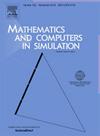Epidemic and unemployment interplay through bi-level multi delayed mathematical model
IF 4.4
2区 数学
Q1 COMPUTER SCIENCE, INTERDISCIPLINARY APPLICATIONS
引用次数: 0
Abstract
An epidemic causes significant financial and economic losses in addition to having negative health effects that result in fatalities.Unemployment is one of the key macroeconomic challenges that governments around the world experience when an epidemic occurs.We have presented a bi-level multi-delay model of epidemics and unemployment to understand and help in alleviating the problem of unemployment while protecting the economy during an epidemic.The epidemic model is the top level of this bi-level mathematical model, and the unemployment model is the lower level.Additionally, the delay in the effect of infection on the unemployed population and the delay in the effect of epidemic-related fatalities on both the employed and unemployed have been taken into consideration.Two equilibrium points, infection-free and interior equilibrium points, have been found.We have obtained the basic reproduction number using the Next Generation Matrix (NGM) methodology.We have also established linear stability analysis around the infection-free and interior equilibrium points, as well as properties of Hopf bifurcation and Lyapunov stability analysis around the interior equilibrium point.Finally, we have conducted numerical simulations to validate the results of our analysis.A time frame for the delays to maintain the system’s stability has been obtained, or else it will adopt instability and it will become very challenging to control unemployment.We propose that the governments implement lockdowns to restrict public social interactions in order to lower the infection rate.We have demonstrated that in order for lockdown measures to effectively reduce infections without driving up unemployment, lowering the incidence of infection-related mortality is essential.It is suggested that adequate and timely treatment be provided in order to control infection-induced mortality.In order to prevent unemployment and infection, it is also suggested that companies offer their employees the chance to work from home. To demonstrate the applicability of our work, we have employed model calibration to fit our model to the real data of COVID-19 impacted people in India, as well as an investigation of calibrated model’s dynamics due to delays has been done.This research will help tackle the serious problem of unemployment during an epidemic, which will spur general economic expansion.
通过双层多延迟数学模型实现流行病与失业的相互作用
我们提出了一个流行病和失业的双层多延迟模型,以了解和帮助在流行病期间保护经济的同时缓解失业问题。疫情模型是这个双层数学模型的上层,失业模型是下层。此外,我们还考虑了感染对失业人口影响的延迟,以及与疫情相关的死亡对就业人口和失业人口影响的延迟,并找到了两个平衡点,即无感染平衡点和内部平衡点。我们还建立了围绕无感染平衡点和内部平衡点的线性稳定性分析,以及围绕内部平衡点的霍普夫分岔特性和 Lyapunov 稳定性分析。最后,我们进行了数值模拟,以验证我们的分析结果。我们得到了维持系统稳定的延迟时限,否则系统将出现不稳定,失业控制将变得非常具有挑战性。我们建议政府实施封锁措施,限制公众的社会交往,以降低感染率。我们已经证明,为了使封锁措施有效降低感染率,同时又不导致失业率上升,降低与感染相关的死亡率是至关重要的,建议提供充分和及时的治疗,以控制感染引起的死亡率。为了证明我们工作的适用性,我们采用了模型校准的方法,将我们的模型与印度受 COVID-19 影响人群的真实数据进行了拟合,并对校准模型因延迟而产生的动态变化进行了调查。
本文章由计算机程序翻译,如有差异,请以英文原文为准。
求助全文
约1分钟内获得全文
求助全文
来源期刊

Mathematics and Computers in Simulation
数学-计算机:跨学科应用
CiteScore
8.90
自引率
4.30%
发文量
335
审稿时长
54 days
期刊介绍:
The aim of the journal is to provide an international forum for the dissemination of up-to-date information in the fields of the mathematics and computers, in particular (but not exclusively) as they apply to the dynamics of systems, their simulation and scientific computation in general. Published material ranges from short, concise research papers to more general tutorial articles.
Mathematics and Computers in Simulation, published monthly, is the official organ of IMACS, the International Association for Mathematics and Computers in Simulation (Formerly AICA). This Association, founded in 1955 and legally incorporated in 1956 is a member of FIACC (the Five International Associations Coordinating Committee), together with IFIP, IFAV, IFORS and IMEKO.
Topics covered by the journal include mathematical tools in:
•The foundations of systems modelling
•Numerical analysis and the development of algorithms for simulation
They also include considerations about computer hardware for simulation and about special software and compilers.
The journal also publishes articles concerned with specific applications of modelling and simulation in science and engineering, with relevant applied mathematics, the general philosophy of systems simulation, and their impact on disciplinary and interdisciplinary research.
The journal includes a Book Review section -- and a "News on IMACS" section that contains a Calendar of future Conferences/Events and other information about the Association.
 求助内容:
求助内容: 应助结果提醒方式:
应助结果提醒方式:


